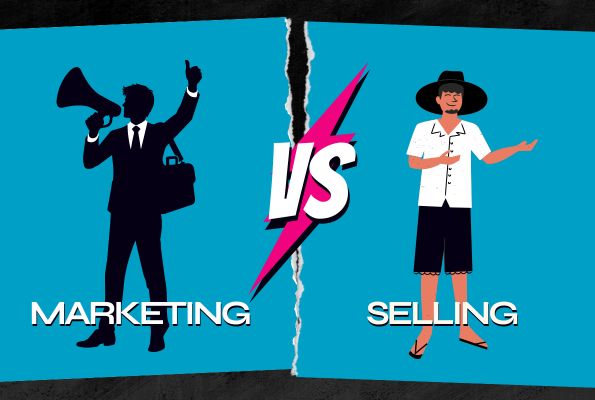
Marketing a product isn’t just about selling it. It’s about creating a connection with your audience, understanding their needs, and offering them a solution that adds value to their lives. It involves deeply understanding their needs, preferences, and pain points, and then positioning your product as the ideal solution that enhances their lives. Whether you’re introducing a brand-new product to the market or revitalizing an existing one, effective marketing is crucial to capturing attention and driving engagement.
Whether you’re launching a new product or trying to breathe life into an existing one, this guide will walk you through the steps to make your product stand out in the crowded marketplace. We’ll cover actionable steps, provide real-world examples, and offer insights into overcoming common challenges. By the end of this guide, you’ll be equipped with the knowledge and tools to make your product shine and resonate with your target audience.
Is Marketing Different from Selling?

At first glance, marketing and selling might seem like two sides of the same coin. But they serve different purposes. Let’s break it down:
Selling is about convincing someone to buy what you’re offering, often focused on closing the deal as quickly as possible. It’s typically a focused, transactional activity aimed at closing the deal as quickly as possible. Imagine you’re at a car dealership—selling is like the salesperson trying to get you to sign on the dotted line. The emphasis is on making the sale happen, often with a sense of urgency.
Marketing, on the other hand, is about understanding your audience and building relationships. It’s a strategic process that involves researching, planning, and communicating in a way that makes your product not just available but desirable. It’s about understanding your audience, building relationships, and creating a compelling story around your product. Marketing involves researching your target market, planning your approach, and communicating in a way that makes your product not just available but genuinely appealing.
Example: Think of Apple. They don’t just sell iPhones; they market an experience—a lifestyle. Their marketing isn’t just about the features of the phone; it’s about how the iPhone fits into and enhances your life. It’s about understanding your audience, building relationships, and creating a compelling story around your product. Marketing involves researching your target market, planning your approach, and communicating in a way that makes your product not just available but genuinely appealing.
How Marketing Can Help Your Product Business
Marketing does more than just get your product in front of potential customers; it helps you create a brand, establish trust, and build long-term relationships with your audience.
Here’s how marketing benefits your product business:
Brand Awareness
Marketing is crucial for making sure your product doesn’t just exist but is recognized and remembered by your target audience. This goes beyond just putting your product on social media or running ads. It’s about crafting a compelling brand presence through consistent messaging, engaging content, and strategic promotions. Think of it as laying the foundation of your product’s identity so that when people think of your category, your brand comes to mind first. Effective marketing ensures that your product is recognized by the right audience. This involves everything from social media presence to content marketing.
Customer Engagement
One of the most significant advantages of marketing is the ability to engage directly with your customers. Through various channels like social media, email marketing, and interactive content, you can communicate with your audience, gather valuable feedback, and make them feel heard and appreciated. This two-way interaction helps in building a community around your product and turns casual buyers into loyal advocates. Through marketing, you can interact with your customers, gather feedback, and make them feel valued.
Driving Sales
While marketing itself isn’t about making a direct sale, it plays a pivotal role in driving sales. Effective marketing strategies create buzz, generate interest, and build demand for your product. By positioning your product as the solution to your audience’s needs and desires, marketing helps to make it the preferred choice in a crowded market. While marketing isn’t selling, it certainly drives sales by creating demand and making your product the preferred choice in a competitive market.
Example: Look at Nike’s “Just Do It” campaign. This isn’t just a catchy slogan; it’s a powerful message that resonates deeply with their audience. It encourages people to push their limits and strive for greatness. This emotional connection not only strengthens brand loyalty but also drives sales by inspiring customers to choose Nike as their go-to brand for sportswear.
In essence, marketing isn’t just about pushing your product out into the market; it’s about creating a compelling narrative, building meaningful relationships, and setting the stage for long-term success. By investing in effective marketing strategies, you’re setting your product up for greater visibility, stronger customer connections, and increased sales.
How to Market a Product
Marketing a product is a dynamic process that involves several key steps to ensure your product stands out and resonates with your target audience. Now that you understand the basics, let’s get into the nitty-gritty of marketing a product. This process involves several steps:
Research Your Market
Before you even think about launching your product, you need to understand the landscape you’re entering. This involves gathering insights about your target audience, competitors, and market trends. Here’s how to get started:
Conducting surveys: Create and distribute surveys to gather feedback from potential customers. This helps you understand their preferences, pain points, and what they’re looking for in a product like yours.
Analyzing market trends: Stay updated with industry trends to identify emerging needs and preferences. Look for reports, market research, and trend analyses related to your product category.
Studying competitors: Examine what your competitors are doing. What are their strengths and weaknesses? What strategies are they using, and how can you differentiate your product?
Example: If you’re launching a new skincare line, research what ingredients are trending, what your competitors are offering, and what gaps exist in the market.
Develop a Marketing Strategy
With your research in hand, it’s time to craft a marketing strategy that will guide your efforts. This strategy should encompass:
Defining your unique selling proposition (USP): Determine what makes your product unique and why customers should choose it over others. This could be a special feature, superior quality, or an innovative approach.
Choosing your marketing channels: Decide where and how you will promote your product. Options include social media, email marketing, pay-per-click (PPC) advertising, and more. Each channel has its strengths, so choose those that best reach your target audience.
Setting your marketing goals: Outline clear, measurable goals for your marketing campaign. These could be related to sales targets, website traffic, or social media engagement.
Create Engaging Content
Content is crucial for engaging your audience and driving interest in your product. Your content should be informative, entertaining, and consistent with your brand’s voice. Types of content to consider include:
Blog posts: Write articles that provide valuable information related to your product. This could include how-tos, industry insights, or expert advice.
Videos: Create videos that demonstrate your product, share customer testimonials, or provide useful tips and tutorials.
Social media updates: Share regular updates, promotions, and engaging posts on platforms where your audience is active.
Email newsletters: Send out newsletters that offer exclusive content, updates, and promotions to your subscribers.
Your content should be informative, engaging, and aligned with your brand voice.
Example: If you’re marketing a fitness app, you could write blog posts about workout tips, create videos demonstrating different exercises, and share success stories from users on social media.
Launch and Promote
With your strategy and content in place, it’s time to launch your marketing campaign. This phase involves executing your plans and making sure your target audience is aware of your product. Consider the following actions:
Running ads: Utilize platforms like Google Ads or Facebook Ads to reach a broader audience. Tailor your ads to target specific demographics and interests.
Sending out press releases: Announce your product launch through press releases distributed to media outlets and industry publications.
Collaborating with influencers: Partner with influencers who can promote your product to their followers, providing credibility and extending your reach.
Example: For a new food delivery service, you might run targeted ads on social media platforms aimed at busy professionals, offer a discount for first-time users, and collaborate with local food bloggers to review and promote your service.
Tools to Make Marketing Easier

Hootsuite for managing social media campaigns. It is a comprehensive platform that allows you to manage all your social media accounts from one place. You can schedule posts, monitor your social media performance, and engage with your audience across multiple platforms. It’s particularly useful for businesses looking to maintain a consistent social media presence without getting overwhelmed.
Google Analytics for tracking marketing performance and customer behavior. It is a must-have for any marketer. It provides detailed insights into how visitors interact with your website, which campaigns are driving traffic, and what content resonates with your audience. By analyzing this data, you can make informed decisions to improve your marketing strategies.
SEMrush for keyword research and SEO optimization. It is a powerful tool for keyword research and SEO optimization. It helps you identify the right keywords to target, analyze your competitors, and track your website’s SEO performance. This tool is essential for driving organic traffic to your site and improving your search engine rankings.
HubSpot for marketing automation and customer relationship management (CRM). It is an all-in-one marketing automation and CRM platform that allows you to manage everything from email campaigns to social media posts. It’s particularly effective for nurturing leads and maintaining customer relationships. The tool’s comprehensive analytics also enable you to track the effectiveness of your campaigns and adjust strategies as needed.
Mailchimp for email marketing campaigns. It is one of the most popular email marketing platforms. It offers easy-to-use templates, automation features, and detailed analytics to help you create and manage effective email campaigns. Whether you’re sending out newsletters, promotional offers, or customer surveys, Mailchimp makes it easy to reach and engage with your audience.
Canva for creating visually appealing marketing materials. It is a user-friendly design tool that allows you to create visually appealing marketing materials without needing advanced design skills. From social media graphics to brochures and presentations, Canva offers a range of templates and design elements to make your content stand out.
SurveyMonkey for conducting market research surveys. It simplifies the process of creating and distributing surveys, making it easier to gather valuable insights from your audience. Whether you’re conducting market research, collecting customer feedback, or testing new ideas, SurveyMonkey provides the tools to do it effectively.
BuzzSumo for content research and competitor analysis. It is a powerful content research tool that helps you discover trending topics, identify key influencers, and analyze your competitors’ content strategies. It’s an essential tool for staying ahead of the curve in content marketing.
Ahrefs for competitor analysis and SEO insights. It is another top-tier SEO tool that offers a wide range of features, including backlink analysis, keyword research, and site audits. It’s particularly useful for understanding what your competitors are doing and how you can improve your own SEO strategies.
AdRoll for retargeting ads. It helps you reach potential customers who have already interacted with your brand by displaying targeted ads as they browse the web. Retargeting can significantly improve conversion rates by keeping your product top of mind.
BuzzStream for influencer outreach and PR. It is a tool for managing influencer outreach and PR campaigns. It helps you build relationships with influencers, track communications, and measure the success of your outreach efforts.
Pardot for B2B marketing automation. Pardot, by Salesforce, is a marketing automation platform designed for B2B companies. It helps you create targeted campaigns, manage leads, and track ROI, making it easier to engage with other businesses and drive sales.
Trello for project management and strategy planning. It is a visual project management tool that helps you organize your tasks, set priorities, and collaborate with your team. It’s ideal for keeping track of marketing campaigns and ensuring everything stays on schedule.
Slack for team communication and collaboration. It is a communication platform that allows you to chat with your team in real-time, share files, and integrate with other tools you’re using. It’s perfect for coordinating marketing efforts and keeping everyone on the same page.
Asana for task management and goal setting. It is another project management tool that helps you manage tasks, set goals, and track progress. It’s particularly useful for teams that need to stay organized and focused on their marketing objectives.
Grammarly for content writing and grammar checks. This is an AI-powered writing assistant that helps you improve your content’s grammar, spelling, and style. It’s an essential tool for creating polished, professional marketing materials.
Lumen5 for video creation from blog posts. It is a video creation tool that allows you to turn blog posts and other written content into engaging videos. This is especially useful for repurposing content and reaching a wider audience through video marketing.
Buffer for scheduling and managing social media posts. It is a social media management tool that lets you schedule posts, analyze performance, and engage with your audience across multiple platforms. It’s a great way to maintain a consistent social media presence without spending all your time on it.
Shopify for e-commerce and product listing. It is a leading e-commerce platform that allows you to set up an online store, manage products, and process payments. It’s perfect for businesses that want to sell products directly to customers online.
Zendesk for customer support. It is a customer service platform that helps you manage customer inquiries, track issues, and provide support. It’s an essential tool for maintaining a high level of customer satisfaction.
Salesforce for CRM and sales strategy. It is a comprehensive CRM platform that helps you manage customer relationships, track sales, and analyze performance. It’s particularly useful for businesses looking to integrate their marketing and sales efforts.
Rafflecopter for running contests. It is a tool for creating and managing online contests. It simplifies the process of setting up giveaways, tracking entries, and selecting winners, making it a great way to engage your audience and grow your following.
Gleam for giveaways and promotions. It is another tool for running promotions and giveaways. It offers a range of features to help you engage with your audience and increase your brand’s visibility.
Hotjar for understanding user behavior on your website. It provides insights into how users interact with your website through heatmaps, session recordings, and surveys. It helps you understand user behavior and optimize your site for better conversions.
Crazy Egg for heatmaps and A/B testing. It is a tool for analyzing user behavior on your website through heatmaps and A/B testing. It helps you identify what’s working, what’s not, and how to improve your website’s performance.
Drift for conversational marketing and customer engagement. It is a conversational marketing platform that allows you to engage with website visitors in real-time through chatbots and live chat. It’s an effective way to nurture leads and improve customer experience.
What to Say When Marketing a New Product

Marketing a new product is an exciting but challenging endeavor. It’s not just about getting your product in front of potential customers; it’s about communicating the right message, using the right channels, and overcoming the unique hurdles that come with launching something new. Here’s how to navigate these critical aspects:
Market Entry Strategy for a New Product
Your market entry strategy is the foundation of your product’s success. It’s about carefully planning how to introduce your product to the market in a way that resonates with your target audience and sets you apart from the competition. Here’s what to focus on:
Positioning your product
What makes it different? To make your product stand out, you need to clearly define what sets it apart from existing alternatives. This could be a unique feature, better pricing, or an innovative approach to solving a common problem. Your positioning should be crystal clear and communicated consistently across all marketing channels.
Example: If you’re launching a budget-friendly smartphone, position it as an affordable alternative that offers essential features without the frills. Highlight its value for money, reliability, and practicality.
Choosing the right channels
Where does your target audience hang out? Understanding where your audience spends their time is crucial for selecting the right marketing channels. Are they more active on social media, or do they prefer email newsletters? Do they frequent online marketplaces, or are they engaged in community forums? Your choice of channels should be guided by where your potential customers are most likely to see and engage with your product.
Example: For the budget-friendly smartphone, consider marketing through online marketplaces like Amazon, tech blogs focused on budget-conscious consumers, and social media platforms where you can engage directly with potential buyers.
Setting your pricing strategy
Competitive, value-based, or penetration pricing? Pricing is more than just setting a number; it’s about creating a perception of value. A competitive pricing strategy positions your product against similar products in the market, while value-based pricing focuses on what your target customers are willing to pay for the benefits your product offers. Penetration pricing involves setting a lower price to quickly gain market share and attract price-sensitive customers.
Example: If you’re launching a premium organic skincare line, value-based pricing might be the way to go. Position your product as a luxurious, high-quality alternative to mainstream brands, and set a price that reflects its superior ingredients and ethical production processes.
How to Promote a New Product
Promotion is all about getting your product noticed and generating buzz. Here are some effective strategies to consider:
Offering limited-time discounts
Limited-time discounts create a sense of urgency, encouraging potential customers to act quickly to take advantage of the offer. This can be especially effective during the launch phase when you’re trying to attract early adopters and generate initial sales.
Example: If you’re launching a new subscription service, offer a discount on the first month for a limited time. This lowers the barrier to entry and gives customers a reason to try your product sooner rather than later.
Running contests or giveaways
Contests and giveaways can significantly increase your product’s visibility, especially on social media. They encourage participation and sharing, helping you reach a broader audience. Plus, they create excitement around your product launch.
Example: A new fashion brand might run a giveaway where participants have to share a post and tag friends to enter. This not only spreads the word but also engages potential customers in a fun and interactive way.
Leveraging user-generated content
User-generated content (UGC) is a powerful promotional tool because it provides social proof. When customers see real people using and enjoying your product, they’re more likely to trust your brand and consider making a purchase.
Example: A new food product brand could encourage customers to share photos of their meals using the product with a specific hashtag. Feature these photos on your website and social media channels to build community and authenticity.
The Challenges of Bringing a New Product into the Market

Launching a new product isn’t without its hurdles but there is always success in the end. Some challenges and how to solve them include:
Building brand awareness from scratch
One of the biggest challenges is getting your product noticed in a crowded market. Without an established brand, it can be difficult to gain the trust and attention of potential customers.
Solution: Focus on creating a strong brand identity and consistently communicate your brand’s values and mission. Invest in content marketing, social media campaigns, and partnerships to build visibility over time.
Competing with established brands
Established brands have the advantage of trust, recognition, and often larger marketing budgets. Competing against these giants can be daunting.
Solution: Identify what makes your product unique and emphasize this in your marketing. Whether it’s a niche market, innovative features, or a more personalized approach, leverage your differences to stand out.
Convincing customers to try something new
Customers are often hesitant to switch from a product they know and trust to something new. Overcoming this inertia requires careful strategy.
Solution: Offer incentives like free trials, money-back guarantees, or special promotions to reduce the risk for customers. Highlight testimonials, reviews, and case studies to build credibility and trust.
Example: A startup launching a new productivity app might face tough competition from established players like Microsoft or Google. To succeed, the startup should focus on what makes its app unique—perhaps a more intuitive interface, better integration with other tools, or features tailored specifically to remote workers. Offering a free trial and showcasing positive user feedback can help convince potential customers to give the new app a try.
How to Market a Product FAQs
What’s the best way to start marketing a product?
Begin with thorough market research to understand your audience and identify gaps in the market. Then, develop a strategy that aligns with your brand and goals.
How do I choose the right marketing channels?
Consider where your target audience spends their time. If they’re on social media, focus on platforms like Instagram or LinkedIn. For B2B products, email marketing and LinkedIn might be more effective.
What’s the biggest challenge in marketing a new product?
One of the biggest challenges is building trust and brand awareness, especially in a competitive market. Start small, focus on delivering value, and gradually scale up.



